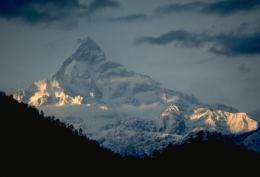Asia home to glacier melt, human vulnerabilities

A new report prepared by scientists from the Joint Global Change Research Institute, a collaboration of Pacific Northwest National Laboratory and the University of Maryland, provides recommendations on how to integrate scientific research and monitoring, as well as health, education, the environment and social organizations, to adequately mitigate the impacts of climate change.
The report, Changing Glaciers and Hydrology in Asia: Addressing Vulnerability to Glacier Melt Impacts, was prepared in collaboration with the U.S. Agency for International Development (USAID). The report was presented at the Woodrow Wilson International Center for Scholars meeting in Washington, D.C., in November.
"The extremely high altitudes and sheer mass of High Asian glaciers mean they couldn't possibly melt in the next few decades," says Elizabeth Malone, a PNNL sociologist and the report's technical lead. "But climate change is still happening and we do need to prepare for it. That's especially true in this part of the world, where poverty and other concerns make its residents very vulnerable to any change."
This report assessed multiple factors to consider how USAID programs could coordinate efforts to respond to the effects of climate change on remote and vulnerable populations in the Himalayas. Researchers gathered scientific data about the region's glaciers, geographic information system-assisted analysis of vulnerabilities, and a survey of existing programs related to glacier melt. Team members worked in consultation with USAID missions and other organizations in the area.
Development agencies should begin now to help prepare for the eventual shrinkage of the massive glaciers in the greater Himalayan region. Programs and projects for this region need to span a wide array of activities, from improving water-use efficiency and cook stoves to promoting cooperative data-gathering and -sharing, to assisting in establishment of family-planning services and health, sanitation, and hygiene practices.
For a complete overview of the report, see the press release "Time to Prepare for Climate Change."
The presentation of this paper will be posted online in a video archive at the Woodrow Wilson Center.
Many people who live in High Asia and along the river basins, fed by the region’s glaciers, already experience malnutrition and food insecurity, insufficient access to clean water and sanitation, and other issues that will be exacerbated by climate change and population growth. The challenge for agencies like USAID is to incorporate climate change into their existing development efforts so that the quality of life continues to improve in the developing world.
More information: Malone E, R Armstrong , et al. 2010. "Changing Glaciers and Hydrology in Asia: Addressing Vulnerabilities to Glacier Melt Impacts." Environmental Research Letters: 5 (October-December 2010) 044005. Doi:10.1088/1748-9326
Provided by Pacific Northwest National Laboratory
















